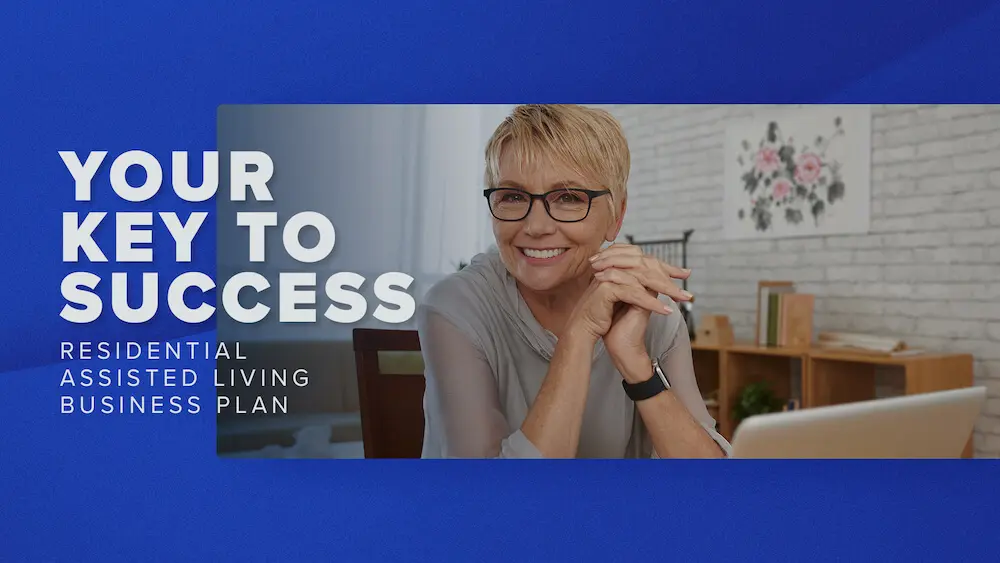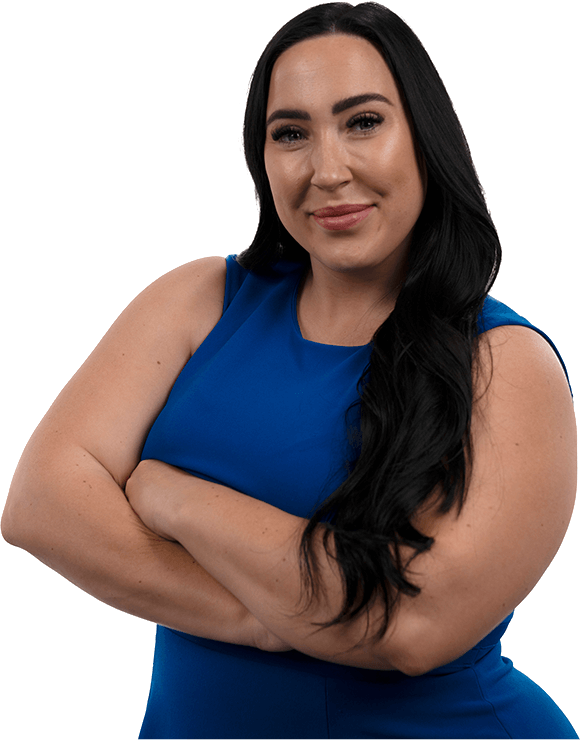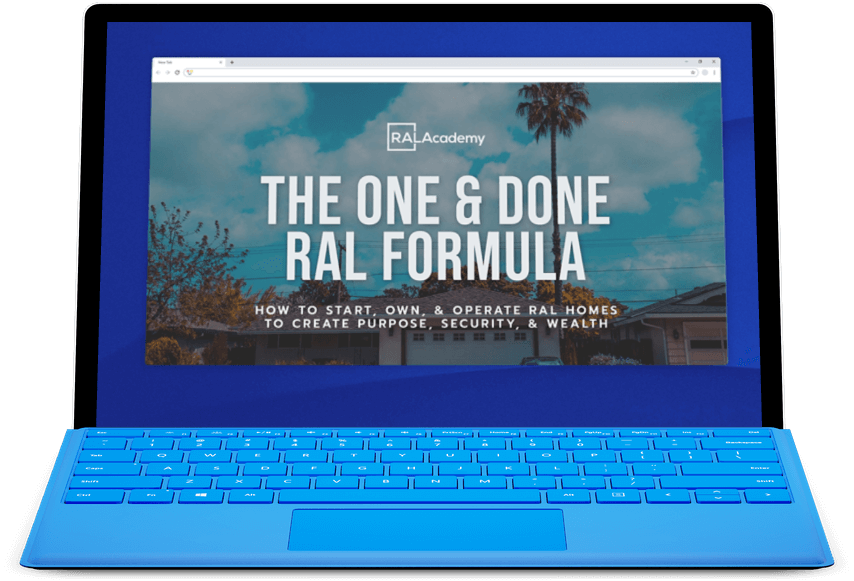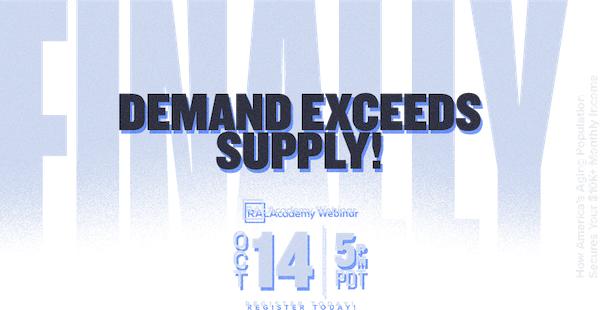Residential Assisted Living is generating A LOT of buzz in the real estate, business, and investment communities right now. A great business plan is the entryway to your success. Not all business plans are created equal. You get just ONE CHANCE to make a “first impression.” Get it right and it can be smooth sailing. Get it wrong… you don’t have a chance.
So where do you start? What are the keys to creating a successful business plan?
With little to no knowledge of senior housing, investors, entrepreneurs, and individuals looking to exit the rat race are seeking out information on how to turn the opportunity of residential assisted living into a profitable business that can provide a sustainable living while elevating the care provided to our seniors.
First of all, you’ve come to the right place. There is a lot to know about creating a profitable assisted living business.
People just like you have started right where you are now, asking themselves all kinds of questions like:
➡ What makes residential assisted living unique?
➡ Are all residential assisted living business models the same?
➡ Do I need to be a medical professional or have field experience to consider this business?
➡ Is this even profitable? How much can I really make?
➡ I’ve never been exposed to residential assisted living, is this for me?
➡ Should I even consider an industry that’s foreign to me?
Or perhaps you find yourself in a position where you know you want to take that next step into owning and operating your very own residential assisted living facility, but you’re unsure of what that looks like.

Reputable people (like Robert Kiyosaki, author of the New York Times Bestseller, Rich Dad, Poor Dad) have begun singing praises for the assisted living model. You’ve bought into the idea that it is a profitable opportunity, but how do you start laying the groundwork?
These are just a few of the many questions that may be swirling through your head. Thankfully, we’re here to provide a framework for helping you understand assisted living, the opportunity, and what goes into a successful assisted living facility business plan.
In this article, we’ll help you with setting up your very own business plan and take you through the two most important elements needed that will gain you the investment you need and set you up to win.
We’ll also teach you the different ways you can get involved in senior housing and benefit from this industry. The opportunities are limitless and we’ll show you how you can get jump in at the level that works best for you.
Let’s begin with the basics and identify Assisted Living.
What Is Assisted Living?
Assisted living is a type of group housing designed to offer care and support to aging seniors who are unable to care for a variety of their basic daily needs. Seniors who take advantage of assisted living have a variety of medical needs and personal care that needs to be attended to.
There are a few assisted living scenarios, but the majority of options provided to those in need are broken down to:
- Rooms
- Apartments
- Shared Living Spaces
- Residential Space
The spaces offered for the residents are usually designed to replicate a home-like environment and typically seek to promote as much independence as possible.
Depending on the health of the individual, residents can be around their peers, share meals, participate in activities and outings, and go about their normal daily routine.
Typical offerings you’ll find in an assisted living facility are:
- Assistance with daily activities (bathing, eating, dressing, etc.)
- Communal dining offering 3 meals per day
- Exercise activities
- Educational activities
- Transportation arrangements
- 24-hour care and emergency services
- Housekeeping and maintenance
Of those models listed above, there is one avenue that has emerged as the most profitable, highest in demand, and provides an opportunity to elevate the overall level of healthcare.
The model you want to pursue is residential assisted living. The remainder of this article will be dedicated to helping you craft a residential assisted living business plan which you can use to then take your next step in the assisted living industry.
What Is Residential Assisted Living and How Is It Unique?
Before diving in, it’s important to understand what residential assisted living truly is and how it differs from other models of assisted living so you can better understand the why behind it.
Simply put, residential assisted living is a group residence for seniors that provides assistance with the residents’ Activities of Daily Living.
Activities of Daily Living, or ADL, is essentially everything you do after getting out of bed each and every morning. These are your day-to-day tasks and while most adults don’t require much thought to accomplish these tasks, for residents of an assisted living facility, they rely on caregivers for nearly all of them.
Assisting with ADL is where the concept of assisted living comes into play.
Doing good for others is not only a wonderful thing, but is truly rewarding. To offer care and assistance to those who can’t help themselves is a tremendous way to live. To be able to do good for others as a business is even better!
At this point, many potential business owners and investors will ask the question, “Do I have to to be the one providing care? I don’t think I’m wired that way.”
No, you do not — and you shouldn’t. The job of a caregiver, like other roles in society, is best filled by someone who is ‘wired’ to provide this type of assistance. We will explore all of the roles to fill a successful RAL, but for now, just know that you will rely on trained caregivers to provide the care your residents need.
Residential Assisted Living Is A Win for Residents and Business Owners and Investors
Being able to play a role in the business without the need to work in the home, actively providing care, is one way that separates residential assisted living from other options.
Another key difference is that residential assisted living is about elevating the care residents receive while helping you create a financial legacy that will serve your family for years to come.
The difference between the residential assisted living model compared to the more common large group assisted living facilities is that the residential option is a home, not an institution.
First, let’s look at how residential assisted living elevates life for the residents.
Three Distinct Components of Residential Assisted Living Homes
Diving deeper into the residential assisted living model, there are three distinct components that separate this model from the rest of the assisted living industry.
The Feeling of Being at Home
Perhaps the strongest argument for residential assisted living is that it provides specialized care for the resident without them sacrificing the feeling of living in their own home.
Here are several more points:
- Custom designed to offer seniors the warm feeling of being at home;
- Strongly encourage the concept of “a home away from home”;
- Implements of décor that remind each elderly resident of their own home;
- Offers intimate settings that prevent seniors from succumbing to loneliness;
- Converts neighbor houses into residential senior living homes;
- Infuses elements of a home environment into their living spaces;
- Focuses on the comfort and consideration of residents more than amenities;
- Recognizes and accommodates the fact that older people miss their homes;
- Infused with warm colors as opposed to a monochromic setting; and
- Paintings, photo albums, and personal pictures stir fond memories.
High Staff-to-Resident Ratios
If you have spent any time in any assisted living facility, you know that a high staff-to-resident ratio is paramount for an excellent standard of care.
Here is a general rule in assisted living: The larger the facility, the larger sunk costs. The more sunk costs, the less money there is to go into staff hiring and training.
You can see where this is going.
The residential assisted living model emphasizes not just trained staff, but elevated staff-to-resident ratios. This allows for a higher standard of care.
Here are a few more bullet points regarding staff-to-resident ratios.
- Staff-to-resident ratios determines the quality of care;
- These important aspects determine the quality of direct care staff;
- Big box facility’s staff-to-resident ratios are as high as 1 staff to 18 residents;
- RAL homes benefit from an average of about 1 staff to 5 residents;
- High residential intake at big box facilities pose obstacles for quality staff-to-resident relationships, limit personal touch, and hinders companionship;
- A limited number of staff increases fall risks and restricts the amount of time available for personal care; and
- RAL home interactive settings improve psychological and physical health.
Slightly Above Average Costs for Upper Class Care
How much does a home in an assisted living facility cost? The answers are wide ranging — however, there is one thing that is ultra important: average isn’t good enough.
In many industries consumers will look at the high end, low end, and then aim for somewhere in the middle. In assisted living, average cost means a poor standard of care.
It’s unfortunate, but it is true.
The good news is that this is, yet another category where residential assisted living shines.
Here are some key bullet points related to the cost to each resident.
- A semi-private room in nursing homes costs about $6,844 per month, some big box facilities are even higher.
- Private facilities cost between $4,500 – $6,000 monthly.
- RAL homes cost about $5,350 per month.
- All assisted living facilities cover the cost of food, care, and medication management. RAL home prices remained fixed, unlike other assisted living billing concepts.
- RAL homes do not increase prices based on the frequency of medication management; unlike other assisted living pricing components.
- All concepts of assisted living are costly, but RAL homes are more cost-effective.
Bottom line, residential assisted living provides the comfort, warmth, and sense of ownership that comes with a traditional home and pairs these traits with qualified caregivers, living in the home, ensuring the health and well-being of each resident.
This is a home where residents, typically seniors, are surrounded by their peers rather than doctors, nurses, and gurneys. They are free to be themselves, feel at home in their own space, and not relegated to a specific room number.
Like larger facilities, residents receive visits from their kids, grandkids, friends, and other loved ones, as well as having the flexibility to go on outings and take advantage of social interactions.
Through the RAL opportunity, you’re providing a home you’d be proud to have your own loved ones in – AND solving a need for millions of people all over the country.
What we’ve found is that the majority of seniors prefer this model. They want to be in their own homes as opposed to a commercial facility where they have less freedom.
Now that you know what Residential assisted living is, maybe you’re wondering if this is for you or if you have what it takes to take advantage of the real estate opportunity that exists within the residential assisted living facility business.

Is the Residential Assisted Living Business Opportunity For Me?
As with any investment you are considering, it’s important to determine whether or not the business will check all your boxes and fulfill your requirements for investing.
The Residential Assisted Living Academy has helped thousands of business owners, entrepreneurs, and investors explore the promising opportunity of this industry; here are some of the things we tell our students to expect from residential assisted living:
- Meaningful Work
- Rewarding Career
- Unlimited Income Potential
- 40 hours a week or less – your choice!
- Security even in a financial down turn
- Time and financial freedom
- Building and passing on a legacy.
- $10K in monthly net cash flow or more
All of these are offered through residential assisted living, yet depending on which role you choose to play, you will either experience some of these first hand or provide them for those who choose to work for you.
If any of the above check your boxes for what a fulfilling and rewarding career opportunity could look like, then being a part of the residential assisted living facility business opportunity is most certainly one you want to consider. Keep reading.
Maybe you’re looking at that list above and wondering if all those things are accurate. And we don’t blame you! So, let’s take a moment and break these down a bit further.
Meaningful work
As we touched on above, operating your own residential assisted living facility will give you the opportunity to do work that’s meaningful. To offer care and assistance through a residential assisted living facility, you are creating a safe and loving environment for seniors to call their own.
The work we’re doing for seniors matters – not just to them, but to their loved ones as well. To know that your parents and/or grandparents are safe, happy, and well taken care of offers peace of mind. What more could you want for your loved ones?
Rewarding
The residential assisted living facility industry is not just profitable, it’s rewarding. When you create a space where people feel welcome and safe, you are adding value and purpose to their lives.
You are giving seniors the chance to live out their later years in comfort and safety, where they feel loved and well taken care of in a space they can call their own.
And it’s not just rewarding for them. People who do more rewarding work are genuinely happier in life. In fact, studies show that 90% of Americans would be willing to take a pay cut if it meant they’d have a more meaningful job.
But what if you didn’t have to take a pay cut and you could still earn well beyond your means, with growing and unlimited potential, all while doing good and meaningful work? You can with the residential assisted living business opportunity.
Unlimited income potential
By tapping into the residential assisted living facility industry, it’s absolutely possible to make $10,000 a month with just one single family home.
You can also get up to twice the fair market rent with a long term, low impact tenant.
Believe it or not, there are a few ways you can get involved in the business that we will break down further later in this article, but it’s entirely possible for you to replace your professional income in one year or less and build a legacy that you can pass on to your children as well.
And, as you’ll see later on, the income potential is limitless depending on the involvement you choose to have and the number of homes that fall under your business.
You could enter this business with just one home. You may decide that’s good, or you may decide to multiply and do two, three, or even more. Could you get by with $10,000-$24,000 NET monthly income?
40 hours a week or less – your choice!
A lot of people are working way too hard. What if you could find something where you didn’t have to work 40 hours a week unless you wanted to? That’s entirely possible and you’ll see how as you keep reading.
There are a variety of ways to get involved in the residential assisted living business opportunity from hands-on operations to being an investor and simply writing and receiving the checks.
So, no matter where you’re at and how much you want to be connected to the day-to-day operations of owning a residential assisted living facility, you can choose the amount of hours you want to work and still make incredible profits.
Security even in a financial down turn
If you’ve worked in the real estate market, you know how drastically the economy can shift and how unsettling that can be for your financial security. But with senior housing, you’ll find security regardless of whatever economic downturns may come.
We will get into the statistics a bit later, but right now here is what you need to know.
In the United States there are 4,000 individuals turning 85 years old EVERY DAY. This is your key demographic. What this amounts to is 1.4 million people EVERY YEAR turning 85 and searching for a home that offers a high standard of care along with a welcoming and homey environment.
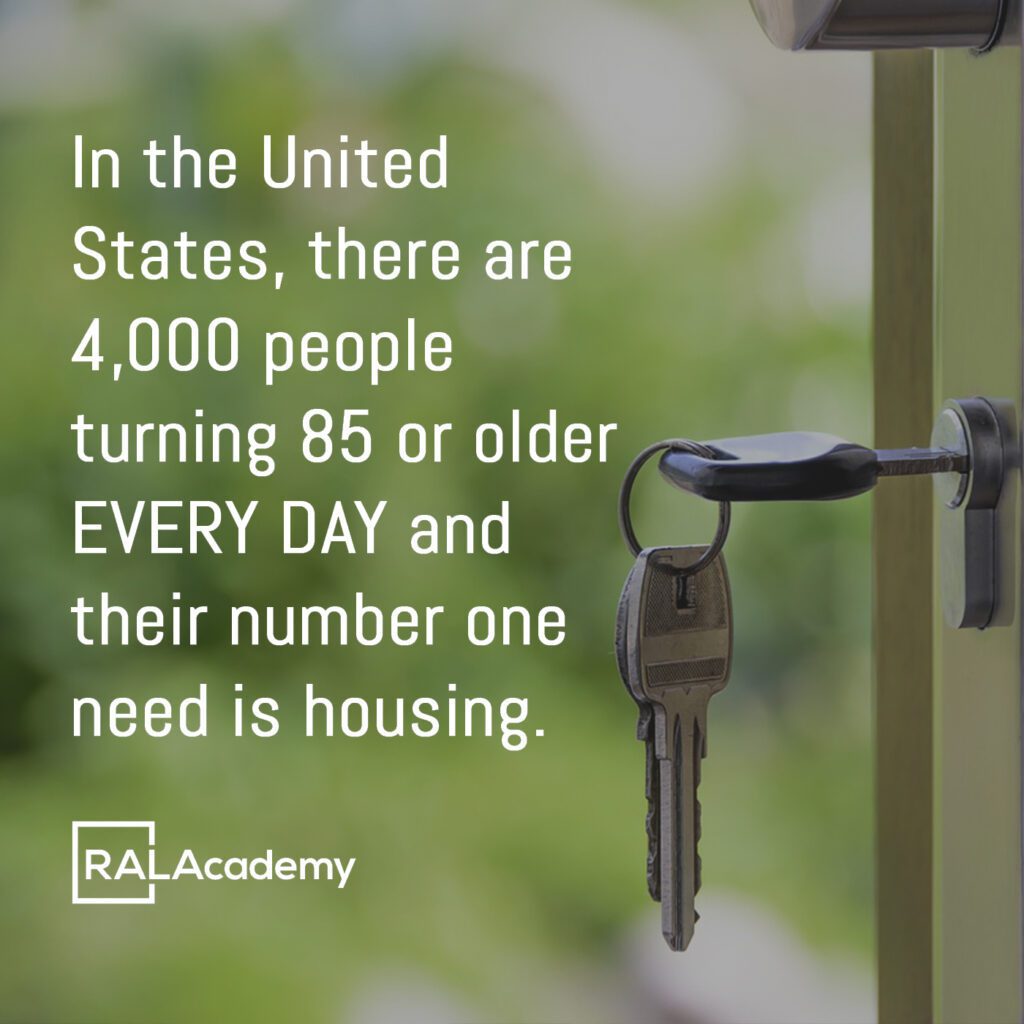
They are going to find a home somewhere — this is where you have the chance to be that home and do good and do well at the same time.
Time and financial freedom
More time and financial freedom are highly sought after, however, very few actually have a business model that will allow them to achieve both in a short amount of time.
As we’ve already touched on, the residential assisted living business plan provides you a pathway to flexibility in the hours you work without sacrificing the money you want to earn.
Time truly is at your disposal in the senior housing industry because you can choose to be as hands-on or hands-off as you like.
If you want to own and operate the residence, you can do that.
If you prefer to fund the operation and leave the logistics to a business manager and the care to caregivers, you can do that.
You can choose to construct your business in the manner you prefer, all while working in a model that can scale regardless of how involved you wish to be.
The sky is truly the limit for earnings – it’s up to you!
Build and pass on a legacy
When the founder of the Residential Assisted Living Academy, Gene Guarino, opened his first home he was looking for a solid solution for how to care for his mother.
After not finding any solution that was good enough for ‘mom’, he decided to revisit an ‘assisted living business model’ he had heard of years before. He opened up his first home to seniors who needed care, just like his mom, and went on to open two additional homes.
Just like Gene, the choice to purchase or convert an existing home into a residential assisted living home is a choice to help others in the short and long term — a legacy of care and financial freedom you can pass on for generations to come.
This business model sets up your children, grandchildren, and great-grandchildren for a future without the burden of providing care for you when the time comes.
This business model eliminates the costly expense of assisted living needs that are in your future — and your family will be able to do the same for their children… all while generating income to fund the cycle.
$10K in monthly net cash flow or more
When we ask many of our students, “How much do you need to earn on a monthly basis to live?” most responses ring in around the $10,000 a month mark.
So, ask yourself the same thing — if you had $10,000 a month in net earnings, would you feel like you had what you needed to make residential assisted living work long term?
Truthfully, $10,000 a month is just the start. You can actually be earning so much more through one of these homes — and that’s what we’re about to get into, so keep reading!
The Business Opportunity of An Assisted Living Facility
The healthcare side of residential assisted living allows you to do well for the sake of others. The business potential of residential assisted living allows you to do well.
It is our hope that you’ve discovered this to be true as you’ve read up to this point.
At this point we’re ready to get into the nitty gritty of understanding the opportunity that is right in front of you and what you can do to leverage it.
Let’s start by taking a look at some important facts.
According to the Pew Research Center, as of December 2010, there are:
- 79 million baby boomers that account for 26% of the U.S. population
- 10,000 people a DAY are turning 65-years-old for the next 19 years
- 4,000 people a DAY are turning 85-years-old
- 90% of seniors would rather stay in their own home
- 70% will need daily care for an average of 3.5 years
Nearly 1.5 million people a year are turning 85 and this is your key demographic. They will need a home and assistance.
This is the residential assisted living opportunity!
These statistics tell the story of a growing customer base who have a unique need and residential assisted living is the opportunity to provide a real solution to fulfill demand.
The opportunity isn’t going away (it’s actually growing daily) and there is a real chance to make a difference while also achieving significant business success.
Three Ways to Get Involved with Residential Assisted Living
As our students discover the need for residential assisted living facilities, they become eager to get involved. This is the point where we will introduce them (and you) to the three ways to play a part in residential assisted living.
You Own the Real Estate and Lease It
In the first scenario, you are the real estate owner and investor. You select a property and pair up with a separate company who will lease the property. This is great for long-term, low impact tenants.
You Own the Real Estate and Operate the Business
The second scenario is where you own the real estate and you operate the residential assisted living business. This doesn’t mean you are caring for the residents, but rather, acting as the business owner and managing the larger operations.
Under this scenario, you will make significant residual income.
Become A Private Lender or Joint Venture Partner
In this third scenario, you are an independent lender or you go in as a joint partner with someone else who acts as the operator.
Investors love this model because it prevents them from having cash standing still and our team at the Residential Assisted Living Academy are able to connect investors with operators to fund projects and keep money growing.
Other Scenarios for Residential Assisted Living
These are not the only three ways to become involved, but they are the most accessible, most profitable ways to become involved. We do have students who will begin pursuing one of our three suggested models and along the way discover a unique opportunity and create their own model, based off of one of these three.
We also like to encourage students that regardless of how much they may want to scale, they should do their own home so as to have a home ready and waiting for the day when someone in the family will need it. Rather than passing off the burden of care to adult children, owners and operators of residential assisted living homes can move their parents into the master bedroom for free and remove the weight of having to find quality care.
Residential Assisted Living is a Real Estate Model
Yes, owning and operating your own residential assisted living facility business is a very specific industry category, but you need to remember that what makes this model tick is the fact that it is a real estate investment first and foremost.
A great deal of wealth and financial gain can be had when you actually own land and the structures on that land.
Background in real estate is not needed, however, because residential assisted living is a real estate model, many with a background in real estate pursue the business because they see first hand, the demand for residential homes.
Seniors are living longer than ever and the majority are not ready for a nursing home — yet they still require a great deal of care. This is the unique need that residential assisted living housing fills, and to build more houses, you must own more land.
One Real Estate Deal to Secure Your Future
At the Residential Assisted Living Academy, we walk individuals through the process of securing their first deal.
How to find seniors.
How to fund the homes.
How to fill the homes.
How to operate a facility.
When you’re done with this one deal, you can allow it to run completely hands off and still generate significant monthly cash flow.
To put it plainly, we’ll show you what it means to be the facility owner, but you will have a facility manager who oversees the caregivers, logistics, and the day-to-day operations in the home.
Residential assisted living represents the biggest real estate boom for the next 25 years and helps ordinary people turn one single family home into a financial legacy.
When we talk about RAL, we take a single family home and convert it into a safe place for seniors to call their own, all while securing a regular, monthly cash flow that far exceeds any other type of real estate model.
As with any business, however, it’s important to set yourself up for success and the only way to do that is to have a solid business plan.

Ensuring Success with an Assisted Living Business Plan
To ensure business success and to ensure funding for your business, you need a business plan.
A business plan creates a roadmap and helps you determine two things: where you’re going and how you’re going to get there.
This plan is essential because it provides clarity for you moving forward, but also demonstrates to others, primarily investors, that you know what you’re doing and you know what you’re talking about.
This framework allows you to gather proper data, do the right research, and formulate a solid plan as you move forward to execute your residential assisted living facility business.
For investors, it shows you’ve done the hard work of investigation and research and you have taken the time to formulate a good plan — one that will succeed.
The number one reason you need to have a business plan is for clarity of vision.
Clarity of vision means you have a thorough understanding of what it is you’re doing and where it is you’re going. When thinking through clarity of vision, it’s important to identify these four elements:
- What it is
- Who you are
- What you’re doing
- Where you’re going
The clarity of vision will communicate that you understand where it is you’re starting, where you’re going to break even, where and when you’ll become profitable, what you’re reserve is, and all the details that support these.
And these are essentials for developing a business plan that will convert to financial backing and raising capital to start you RAL business, which leads us to the other essential piece of a business plan.
The number two reason you need a business plan is for raising capital.
A business plan proves that you have a clear vision, which is what investors will want to see. A solid and well thought-out business plan proves to investors that you have a clear vision and allows you to communicate that vision so that others will essentially buy in to you.
Here are some important things to consider.
Without a business plan:
➡ No bank is going to give you a loan
➡ No private investor or a lender is going to give you money
➡ People are not going to take you or your business seriously
➡ Investors will be unclear about what it is you’re doing and where you want to go with it
➡ Investors will believe that you have unclear ideas about what it is you’re doing and where you want to go with it
To be clear, a business plan is an essential step in the initial phase of any business start-up, despite the industry. A business plan allows you to formulate a clear and thought-out plan that clarifies where you’re wanting to take that plan.
A business plan also allows you to level up and separates you from those who are interested in starting a business to someone who is serious about doing the real work of owning and executing a successful business.
A business plan is essential no matter what industry you are planning to go into. Now that you know the top two reasons for why you need a business plan, let’s break down the essential components of a successful business plan!
The Essentials of A Successful Business Plan and How to Apply It to a Residential Assisted Living Facility
In this section, we’re going to break down the 5 P’s of a successful business plan, regardless of the industry you’re wanting to get into.
1: People — Identify the People Directly Involved with the Business
In any industry – especially in residential assisted living – It’s all about the people who are involved. Investors are going to want to know about the people who are involved in this business.
They’ll be asking, “what have they done in this industry?” or “what have they done that’s similar to this industry?”
And if you you’re thinking, “I don’t have any experience in the residential assisted living industry,” that’s okay. But, it’s important to know before you go into this process, that experience and knowledge is what prospective buyers or lenders are going to be interested in.
So it’s important to surround yourself with others who have done this, or something like it, before. Build a smart team that not only compliments your strengths, but can offer obvious and applicable experience to your business and balance out what you may be lacking personally.
It will be important to identify the people who are directly involved in the business, which means you’ll need to identify and outline their experience and knowledge of the industry by addressing:
- Who you are
- Who your team is
- Who else is operating within the business
Residential assisted living is a people-centered business and you’ll want to show you understand the full scope of what this means as you develop your business plan.
To help you dive further into some of the people involved in a residential assisted living facility, you may find these articles helpful.
- Is Your RAL Manager the Right Fit For Your Business?
- What is the Average Day for the Residents?
- Strategies for Retaining Your RAL Staff
So now that you have the people covered, let’s break down the next “P.”
2: Product — Spell Out What Your Product Is
What is it that you do? It may seem self-explanatory, but it’s really crucial that you spell this out in your business plan.
In the front, you’ll have a section called the Executive Summary, and this 2-3 page section will include all the details about who you are, the product or service you are selling, and your place in the market. And it’s important that you go into a great amount of detail here.
When addressing the product, make sure you are hitting these main points:
- What your product or service is
- What you’re doing with your product or service
This is your chance to show that you know what you’re doing and you have a plan for your product or service.
The next “P” in a successful business plan is position.
3: Position — What Is Your Position In the Market
Essentially, your position is your place in the market.
So let’s unpack this. Are you wanting to be on the high end (think Nordstrom) or the low end (think Dollar Store)? You’ll want to identify this in the product section.
You don’t want to be on the high end, where the clientele is sparse, and you don’t want to be on the low end where you’re battling lots of competition for pennies. Your goal is to be in the sweet spot – somewhere just above the middle.
This is important because you’re not all things to all people, and you don’t want to be either. Claim your position and be clear about where you want to be so you can communicate a clear vision of your target audience.
Check out this video and hear what Gene Guarino, founder of RAL Academy, has to say about “position” and the other P’s needed to formulate a successful business plan.
The fourth “P” takes us to projections.
4: Projections — Show Profitability Through the Numbers
Projections can look different depending on where you’re starting. If you’re buying an existing business, there’s an obvious past, present, and a projection for the future.
Most people who are raising capital for a business are wanting to look at the future projections with the understanding that you’re starting from scratch – ground zero. You’ve clearly laid out that this is a new venture that is classified as a complete startup.
Most potential investors or lenders are going to want to take a close look at those future projections and it’s important to be conservative.
Whatever you think it is, reduce it. For example, if you think the income is going to be 4K per person for rent, make it $3,600. Give yourself breathing room. Make sure you can under- promise and over-deliver so that when it’s all said and done, you come out ahead.
Now let’s talk profitability for a second…
We assume you know that your business must be profitable, which is why projections are so important. Projections will show your profitability to investors by giving them the numbers they’re actually interested in.
Investors don’t initially want to know how much money they’re going to make up front or what’s in it for them. They need and want to know their money is safe, there is a purpose, that you know what you’re doing, and you’ve surrounded yourself with the right people.
They need to know that you know your position and your projections. The profit should be self-evident when your position is clearly determined, and when it is, it shows that your financials are in place.
Bottom line: Investors are looking for safety of capital – that is their number one concern.
And now on to our fifth and final “P” to include in developing your successful business plan.
5: Plan for Your Exit — Help Investors See When They Will Get Out of the Deal
Believe it or not, most business plans are missing this essential element. But lenders who are investing their dollars to support any business want to know what the exit strategy is – they need to know when and how they will get their money back.
In a normal business plan – especially something as simple as residential assisted living – it’s important to lay out a clear solid exit plan – one that communicates to investors that their money is safe, what the collateral is, and what the positioning is.
A 2-5 year exit plan is what we recommend.
This means that the investors money is committed for two years, and once the business is stabilized, there is either a plan to sell or refinance. The investor wants to know that they are eventually going to get out of the deal.
When you start applying the above principles to your residential assisted living facility business plan, you’ll be on the road to taking a solid step towards success in this industry.
Through the RAL Academy, we offer a variety of training courses to further break down the steps for developing a business plan and get you started on the right track for starting your very own residential assisted living facility.
Although we offer a variety of courses to meet your needs and demanding schedule, we highly recommend starting with the RAL Accelerator Certified Home Study Course, which you can take online in the comfort of your own home. You can learn more and sign up here.
Now that we’ve laid the groundwork for getting you started in your very own residential assisted living facility business, let’s get into what this business opportunity truly entails.

Explaining the Residential Assisted Living Business Opportunity
The RAL opportunity is a true real estate model — real estate is the key to open the door to wealth — but having a residential assisted living facility provides you with a bonus opportunity to do good while doing well at the same time.
By now you’re aware of the huge financial benefits offered through the residential assisted living business, but have you considered the tremendous opportunity this business holds for you to not only build wealth, but do good for others by providing a better housing solution?
The income potential is clear, but the growing need of assisted living is not going away.
We know that taking a single family home and earning upwards of $10,000-$15,000 of NET cash flow each month is achievable in this business – and you don’t even have to be hands-on!
But this is truly an opportunity that you can’t stop, and we call it the Silver Tsunami of Seniors. This business is good right now and it’s just getting better, as Baby Boomers age and are living longer than ever before.
We touched on this in the beginning, but take a closer look at these statistics again:
- There are 79 million baby boomers in the US
- 10,000 people a DAY are turning 65 years old
- 4,000 people a DAY are turning 85 years old
- 90% of seniors would rather stay in their own home
- 70% will need daily care for an average of 3.5 years
This is certainly a growing need that just keeps getting bigger, and the baby boomer demographic is truly an opportunity to leverage the growing need and desire for accessible housing that more than meets the demand.
Senior housing and assisted living are the gateway to you being able to turn a single family home into a cash flowing machine.
Now that you understand the essential elements of having a successful business plan and how to apply it specifically to your residential assisted living facility business, let’s take a look at some frequently asked questions that come with the RAL business model.
Questions About the Residential Assisted Living Business Model
As with any business, especially when just starting out, it’s common to have questions. And the more you learn, the more questions you’ll uncover. So, let’s look at some frequently asked questions as it pertains to the residential assisted living industry and unpack some reservations you may have.
Question 1: How Hands-on do I Need to be?
As we’ve covered above, you can be as hands-on or hands-off in your assisted living business as you want. There are a couple of different angles you can take with your business, but in the RAL Academy we typically will teach you more of a hands-off model: you are set up as the business owner, but have a property manager who oversees the staff and the day-to-day operations of the business.
Again, there are different approaches you could take, but the bottom line is that it’s your call. You can go into this business with either approach – whatever works best for you – and be successful!
Question 2: How will I find a staff?
Through the RAL Academy training course, we will break down the best ways to find and hire the right staff for your residential assisted living facility.
Unemployment is low in our country. Finding good people is a bit more challenging in the current economy. You could put an ad on Craigslist for caregivers and you will get applicants. The question is, are they good and do you want them for your residents?
Critical to the success of Gene’s own RAL homes is the quality of the caregivers and it will be critical to your success as well.
There is a precise skill set that you need to learn in order to identify, hire, train, grow, and retain caregivers that your residents will love and you will find indispensable. This skill set is exactly what we teach during our training courses.
Question 3: What Does the Average Day Look Like for a Facility Manager?
The number one job for the manager is to make sure that everything runs smoothly.
Gene is not the manager of his homes, he is the business owner and the business manager. The home manger is there, day-to-day, making sure the caregivers are there, making sure the residents are in place, the home is full, and the family is being taken care of.
The day-to-day for a manager really isn’t one day, it’s more of a 24/7 – they’re ready to go at any time and their days are very different each day. Still, they do have a certain set of responsibilities that they must take care of.
The manager is the key person in your business.
Question 4: Can I use my own home for the assisted living facility?
You have a home – can you use it as a residential assisted living home? Maybe yes – but just because you can doesn’t mean you should. The biggest and most important piece of this puzzle is location, location, location. Is it near the right people? Is it near the right demographic?
If it’s near a college campus where the average age is 30-years-old and these 30-year-olds have parents in their 50s and 60s who are not in assisted living, that’s not an ideal location.
However, if your home is in an area where the average age is 50-60 years old and their parents are 80 and 90 years old, that’s the right neighborhood.
You’ll then want to look at economics. Are the residents in the area middle-class and below or middle-class and above? A successful, residential assisted living property will want residents in the upper middle income, making location critical.
You don’t need to worry about the home structure itself. We can scrape it away and build it new. It’s the location that we want to be certain is a fit.
Question 5: Can I do Residential Assisted Living With or Without My Own Money?
Yes, you can! We show our students how to do RAL with their own money or how to use other people’s money. When you think about it, borrowing from a bank is borrowing other people’s money. When you bring in outside lenders, investors, or private individuals those are all options utilizing other people’s money.
A lot of times people will think, “Oh, I have to have skin in the game,” and they believe they have to have their own money in. That’s not how we think about it. If you’re putting in the time, the effort, you have the plan, and you’re willing to do the work, you’re putting a lot of skin in the game.
Others have the money and are looking for something or somebody to invest in. That can be you! But you need to know what you’re doing. That’s where we come in. We’ll show you exactly what to do – whether using your own money or someone else’s. The choice is yours. You decide.
These are just some of the many questions we receive on a regular basis – and this content just scratches the surface to what we unpack through the RAL training courses we offer.
As with any business – but especially with the residential assisted living opportunity – you want to be sure you have a thorough understanding of what it is you’re getting involved in and how you can build a successful business that will allow you to do good and do well.
The RAL opportunity is full of very important details that you’ll need to know – especially prior to putting together your assisted living facility business plan. But we’re here to equip you with what you need to get started in the senior housing industry and do incredibly well in this highly lucrative industry.
Now that we’ve covered some of the frequently asked questions that come with thinking about starting your own residential assisted living facility, let’s look at what it takes to actually open your own successful assisted living facility.
Opening Your Own Assisted Living Facility
We’ve covered some basic and essential groundwork and provided a significant amount of details as it relates to the essentials of what goes into a successful residential assisted living plan.
Now let’s take a look at what it takes to actually open your own assisted living facility and how you know if you’re the right person to pursue this business after all.
How to Know If You Should Pursue A Residential Assisted Living Business
Who is the best fit to run a business? Our company slogan is “do good and do well.” This essentially boils down to the fact that the assisted living industry is one that provides a very important and beneficial service that ultimately helps add to the quality of life of others. Because of this nature, you have the opportunity and benefit of doing good in this business.
Additionally, residential senior housing is incredibly lucrative and has increasing levels of profitability. Because it’s truly a real estate model – and the best one for the next 25 years! – it also provides the opportunity for you to do well.
If you want to know if the RAL opportunity is right for you, than you need to be someone who values people and takes pride in doing work that, in turn, makes a positive difference in the lives of others. You also need to be someone who values and appreciate an excellent financial opportunity – someone who is okay with making a lot of money while doing good for others.
You don’t need to have experience in the assisted living industry to do well in this business. You don’t even need experience in real estate. You just need to have a passion for making money while also doing good for others at the same time.
If that’s you and you have the desire and drive to learn what it takes to run a successful residential assisted living facility, then you will do good and do well in this business – and we can show you how and the next steps you need to take to get you there!
Taking Your Next Step to Opening Your Own Assisted Living Facility
The first thing you’ll want to do is decide if you want to go into the residential assisted living business on your own or if you’d like to accelerate the process by working with other industry professionals.
As you’ve discovered, the senior housing business opportunity requires a great deal of knowledge, but we’re confident in being able to equip individuals for success through our proven process that will give you the tools you need to be succeeding in this business.
The knowledge you’ll receive will not only prepare you for owning and operating a residential assisted living facility, but it will accelerate the process in such a way that you could be earning $10,000 or more in NET cash every month in less than a year.
You’ve already taken an important step by researching the residential assisted living facility business opportunity and what it entails.
But where do you go from here? We’ve developed the Assisted Living Business Accelerator Online class that will break it all down and equip you to go further in your RAL business.
Through the Assisted Living Business Accelerator online class you’ll learn:
- How to find the best opportunities for RALs in any area
- How to determine if your own property is right for a RAL
- How to attract investors and partners
- How to find the right team to make your life easy
- How to fill your RAL with the highest paying clients
- How to do it with or without your own money
- The FAST TRACK to your first RAL in 3-6 months from TODAY
- How to do one deal and be set for life
You may be looking at this list and thinking, “wow, that’s a lot of information!” And you’d be right! But this information is crucial to owning and operating a successful RAL business and these are the building blocks you need to prepare for a lucrative and lasting future in this industry.
Wrapping Up: Success With a Residential Assisted Living Business Plan
As we’ve discussed, having a plan gives you a roadmap, which is essential to take you from where you are to where you want to go. The roadmap – or business plan – will determine where it is you’re going and how it is you’re going to get there.
The Assisted Living Business Accelerator Course will give you the necessary tools you need to create a solid roadmap that will put you on the path to RAL success, which is the only path you want to be on!
As soon as you understand the importance of having a successful business plan and how to apply that to your residential assisted living business, you’ll be able to go farther, faster, and save yourself time and money throughout the process.
Having a solid business plan will also allow you to benefit because others will see that you know what you’re doing and where you’re going – and those important people will be willing to invest in you, which will help make your RAL business a reality.
A business plan proves you’ve thought it through, figured out what the challenges are, the situations that may come up, and the strength and weaknesses that are working for or against you.
It’s important to have a business plan – to have it laid out properly and understand the main elements of it. When you have a plan and surround yourself with people that can help make you successful, you can absolutely do this.
There’s a lot to know, but when you have a well executed business plan, you are setting yourself up for success and you will be able to do good and do well in the residential assisted living facility opportunity.


